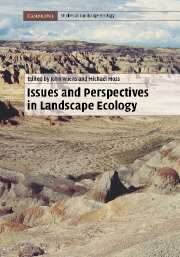Book contents
- Frontmatter
- Contents
- List of contributors
- Preface
- PART I Introductory perspectives
- PART II Theory, experiments, and models in landscape ecology
- PART III Landscape patterns
- PART IV Landscape dynamics on multiple scales
- 14 Landscape sensitivity and timescales of landscape change
- 15 The time dimension in landscape ecology: cultural soils and spatial pattern in early landscapes
- 16 The legacy of landscape history: the role of paleoecological analysis
- 17 Landscape ecology and global change
- PART V Applications of landscape ecology
- PART VI Cultural perspectives and landscape planning
- PART VII Retrospect and prospect
- Index
- Plate section
- References
17 - Landscape ecology and global change
from PART IV - Landscape dynamics on multiple scales
Published online by Cambridge University Press: 20 November 2009
- Frontmatter
- Contents
- List of contributors
- Preface
- PART I Introductory perspectives
- PART II Theory, experiments, and models in landscape ecology
- PART III Landscape patterns
- PART IV Landscape dynamics on multiple scales
- 14 Landscape sensitivity and timescales of landscape change
- 15 The time dimension in landscape ecology: cultural soils and spatial pattern in early landscapes
- 16 The legacy of landscape history: the role of paleoecological analysis
- 17 Landscape ecology and global change
- PART V Applications of landscape ecology
- PART VI Cultural perspectives and landscape planning
- PART VII Retrospect and prospect
- Index
- Plate section
- References
Summary
We often hear that the world is growing smaller. “Globalization” via rapid air travel, trade agreements, the internet, and a highly migratory global population are rapidly turning the earth into one very large landscape. Land-use change, once thought to be only a local phenomenon, is now of such a scale as to alter the composition of the atmosphere and to affect climate in far distant locations from the original perturbation. Industry across the globe, driven largely by fossil fuel combustion, has altered the composition of the atmosphere and is now clearly warming the earth's climate and producing complex responses and feedbacks between the earth's surface and its atmosphere. The global changes in the atmosphere, oceans, and land surface have forced the development of large-scale models both to understand the responses and feedbacks of change and to “predict” or forecast possible future changes, with the possibility of interventions to forestall or slow the onset of negative consequences. Since the issues of global change are by definition global, the models of atmosphere, oceans, and terrestrial biosphere are constrained to relatively coarse grids, due largely to computational limits. Unfortunately, in all three “spheres” many of the processes that determine the large-scale patterns occur at sub-grid scales. Dynamic Global Vegetation Models (DGVMs), for example, are typically implemented at 0.5° latitude–longitude resolution (c. 50-km resolution). Yet most of the patterns and processes fundamental to ecosystem modeling are sub-grid scale (landscape and lower levels), rendering global simulations a challenging enterprise.
- Type
- Chapter
- Information
- Issues and Perspectives in Landscape Ecology , pp. 167 - 178Publisher: Cambridge University PressPrint publication year: 2005
References
- 1
- Cited by



